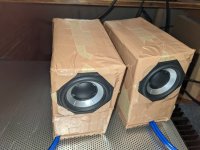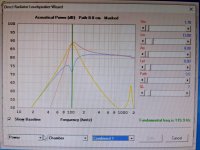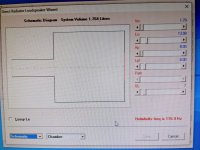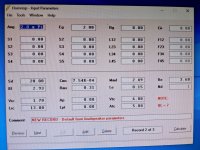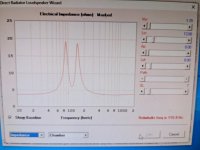Thanks for the data and info!
I'm less concerned about lobing in the vertical plane, so long as the main listening area is covered reasonably well (+/- a few degrees vertically), but horizontal lobing is more detectable. I'm also hoping that the diminishing hearing acuity in the HF range will help to hide the transition.
Looks like some experimentation is in order.
All the best,
Chris
I'm less concerned about lobing in the vertical plane, so long as the main listening area is covered reasonably well (+/- a few degrees vertically), but horizontal lobing is more detectable. I'm also hoping that the diminishing hearing acuity in the HF range will help to hide the transition.
Looks like some experimentation is in order.
All the best,
Chris
I want to have advice for designing small vented box.
This is what I simulated on hornresp.
There is bump at bottom.I am not expecting flat response for this small driver.
This is what I simulated on hornresp.
There is bump at bottom.I am not expecting flat response for this small driver.
Attachments
Tuned too high. I used Vb=1.36 litres, Fb=79Hz. Also did one at 1.3 litres with a PR tuned to around 80Hz.
I recognize that f0 means ability for low frequency or speaker.
Lower than fo sounds like dead bass and higher than fo sounds living bass...
So I tuned abave 115hz.
But I am new so need opinion for tuning frequency.
Lower than fo sounds like dead bass and higher than fo sounds living bass...
So I tuned abave 115hz.
But I am new so need opinion for tuning frequency.
A tuning of 75Hz gives the shortest spike, but still not ideal.
Hornresp gives a sharp spike, WinISD only gives a small humps of a couple of decibels. HornResp is a much newer sim package and well supported. So, I would tend to believe it.
I don't think "above" 115Hz qualifies as bass. Let's face it. A single SB65 will not give meaningful bass, even sitting very close to them.
They are best used when supported by something with more meat below. Free them around 250Hz or above that, and they will sing.
Hornresp gives a sharp spike, WinISD only gives a small humps of a couple of decibels. HornResp is a much newer sim package and well supported. So, I would tend to believe it.
I don't think "above" 115Hz qualifies as bass. Let's face it. A single SB65 will not give meaningful bass, even sitting very close to them.
They are best used when supported by something with more meat below. Free them around 250Hz or above that, and they will sing.
I don't know what's inside these Mini La Scala's. I like the looks.
Many years ago I almost bought a pair of La Scala's for $600 cdn.
But I thought my wife would not be impressed, low waf.
La Scala
https://d2um2qdswy1tb0.cloudfront.net/files/Heresy-II-La-Scala-Belle-Klipsch-brochure-and-specs.pdf
About the size of this 5 cu ft freezer.
http://tomorrowyours.com/top-5-black-chest-freezer-5-cu-ft-compact-refrigerators/
Many years ago I almost bought a pair of La Scala's for $600 cdn.
But I thought my wife would not be impressed, low waf.
La Scala
https://d2um2qdswy1tb0.cloudfront.net/files/Heresy-II-La-Scala-Belle-Klipsch-brochure-and-specs.pdf
About the size of this 5 cu ft freezer.
http://tomorrowyours.com/top-5-black-chest-freezer-5-cu-ft-compact-refrigerators/
more for fun-these might be easier-Mini Altec VOTT
http://www.audioheritage.org/vbulletin/showthread.php?10185-mini-Altec-Voice-of-the-Theater
http://www.kcn.ne.jp/~sugiura/page033.html
scale it down

http://www.audioheritage.org/vbulletin/showthread.php?10185-mini-Altec-Voice-of-the-Theater
http://www.kcn.ne.jp/~sugiura/page033.html
scale it down
Last edited:
scale this down @ 1/2
http://www.audioheritage.org/vbulletin/showthread.php?2452-1-4-scale-828-A7-cabinets
http://www.audioheritage.org/vbulletin/showthread.php?2452-1-4-scale-828-A7-cabinets
Various plans, etc.-
http://eco-speaker.sblo.jp/archives/201306-1.html
http://web.archive.org/web/20021019111413/http://space.tin.it/scienza/0galavot/limes.html
http://www.giulianonicoletti.com/public/limes.pdf
http://www.mh-audio.nl/plans/other plans/Hedlund Horn.pdf
https://darklanternforowen.wordpress.com/2015/01/03/mauhorn-iv/
http://www.mh-audio.nl/plans/other plans/Hedlund Horn.pdf
http://www.sonido.hu/epitsd-magad.php?lang=en
https://sites.google.com/site/speak...back-loaded-horn-enclosures-for-single-driver
http://www.diyaudioprojects.com/Speakers/Fostex-FE103E-Zigmahornets/
http://networkentry.blog22.fc2.com/blog-entry-164.html
https://www.diyaudio.com/community/threads/hivi-b3s-in-mini-transmission-line.106632/
?
http://www.6moons.com/audioreviews2/finale/1.html
https://www.petoindominique.fr/php/pavar.php
http://eco-speaker.sblo.jp/archives/201306-1.html
http://web.archive.org/web/20021019111413/http://space.tin.it/scienza/0galavot/limes.html
http://www.giulianonicoletti.com/public/limes.pdf
http://www.mh-audio.nl/plans/other plans/Hedlund Horn.pdf
https://darklanternforowen.wordpress.com/2015/01/03/mauhorn-iv/
http://www.mh-audio.nl/plans/other plans/Hedlund Horn.pdf
http://www.sonido.hu/epitsd-magad.php?lang=en
https://sites.google.com/site/speak...back-loaded-horn-enclosures-for-single-driver
http://www.diyaudioprojects.com/Speakers/Fostex-FE103E-Zigmahornets/
http://networkentry.blog22.fc2.com/blog-entry-164.html
https://www.diyaudio.com/community/threads/hivi-b3s-in-mini-transmission-line.106632/
?
http://www.6moons.com/audioreviews2/finale/1.html
https://www.petoindominique.fr/php/pavar.php
Last edited:
Hello GM.It has a ~1" dia. VC, so ~13543/pi = ~ 4311 Hz, ergo the BW above ~ this point is normally radiating off the dustcap/glue joint
I am listening sb65wbac recently and feels metallic distortion sometimes.
Could you explain me how to calculate frequency a little more?
Greets!
Simple enough; 'sound is round', so SoS/pi/desired diameter = Hz and in theory the driver is pistonic from Fs to either the VC dia. or oversize dustcap, whichever is larger, but the reality is that ofttimes there will be breakup modes due to diaphragm design to maintain a nominally flat response as sound power rolls off with increasing frequency, polar response collapses, so historically 'we' used a mechanic's stethoscope to find peaks/dips/whatever in the response, though now there's powerful computer programs to measure, map drivers/whatever to high resolution, though others will have to help with that.
Simple enough; 'sound is round', so SoS/pi/desired diameter = Hz and in theory the driver is pistonic from Fs to either the VC dia. or oversize dustcap, whichever is larger, but the reality is that ofttimes there will be breakup modes due to diaphragm design to maintain a nominally flat response as sound power rolls off with increasing frequency, polar response collapses, so historically 'we' used a mechanic's stethoscope to find peaks/dips/whatever in the response, though now there's powerful computer programs to measure, map drivers/whatever to high resolution, though others will have to help with that.
I am sorry for noob questions that what is SosSSoS/pi/desired diameter = Hz
SoS = 'speed of sound' in audio, which is a variable depending on where you are, though when using Hornresp software it assumes that the velocity of sound in air is 344 metres per second, and that the density of air is 1.205 kilograms per cubic metre.
- Home
- Loudspeakers
- Full Range
- SB Acoustics SB65WBAC25-4 - What to do?
